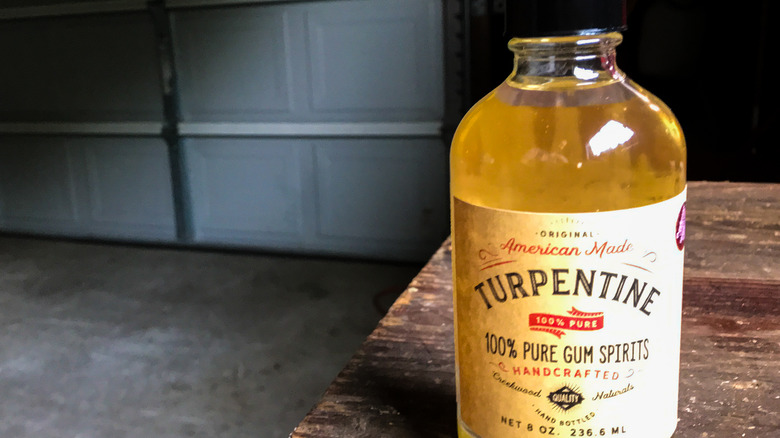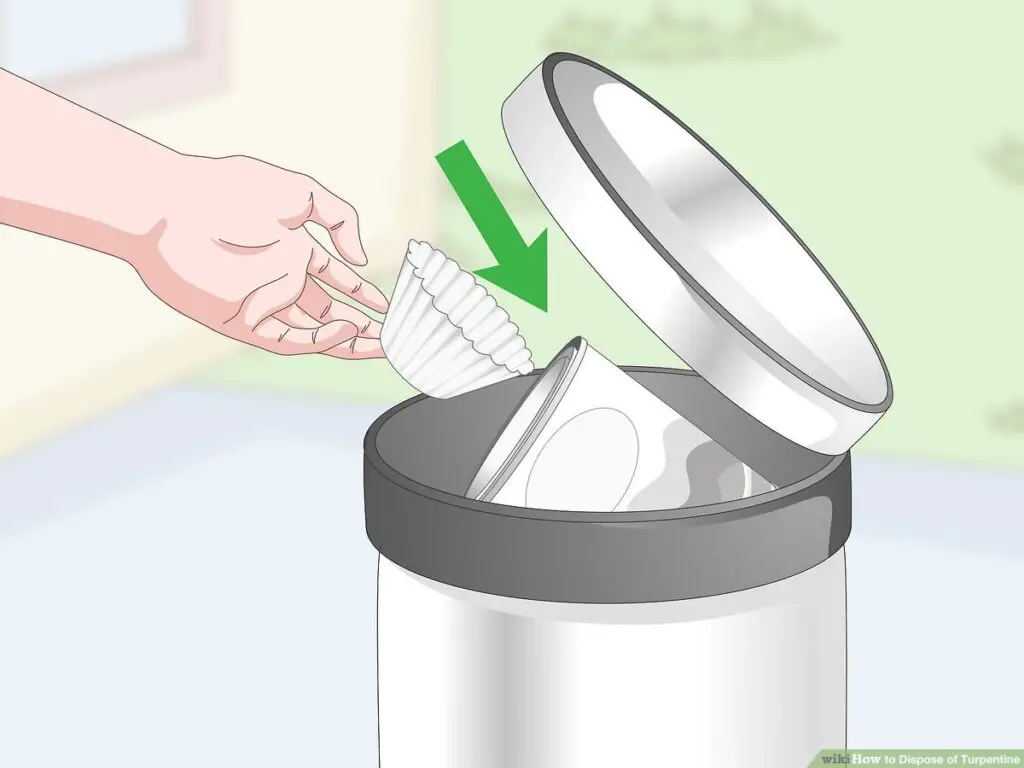Dispose of turpentine by taking it to a hazardous waste disposal facility; never pour it down drains or into the environment. Contact your local waste management authority to determine the proper disposal site.
Turpentine, a common solvent used in painting and woodworking, requires careful handling and disposal due to its flammable and toxic nature. Proper disposal is not only crucial for environmental protection but also for personal safety and adherence to local regulations.
As household hazardous waste, turpentine can contaminate water and soil, posing risks to wildlife and human health. Awareness and compliance with appropriate disposal methods are essential in minimizing these hazards. Dispose of your turpentine responsibly to ensure a safer ecosystem and to keep your community clean.
The Basics Of Turpentine Disposal
When working with turpentine, proper disposal is key. This substance, often used as a solvent or paint thinner, is not for your regular trash bin. To keep your family and environment safe, learn the correct disposal methods.
Identifying Used Turpentine
Spotting used turpentine is the first step in the disposal process. It often looks cloudy or has a color change due to the mixture with paint residues.
- Check the cleanliness: If it’s not clear, it’s probably used.
- Smell: Strong, pungent odor points to contamination.
- Label containers: Always label jars with ‘used turpentine’.
Environmental Concerns With Improper Disposal
Improper disposal harms nature and animals. Turpentine can contaminate soil and water.
| Problem | Consequence |
|---|---|
| Water Pollution | Hurts aquatic life |
| Soil Contamination | Affects plant growth |
| Fire Hazard | Can cause spontaneous combustion |
Follow local regulations for hazardous waste disposal.
Never pour turpentine down the drain or onto the ground.
Safety Measures For Handling Turpentine
Turpentine, a volatile and flammable solvent, demands respect and careful handling. Implementing proper safety measures can prevent accidents, ensuring a safe environment for use.
Personal Protective Equipment
Personal safety comes first. Always wear the right gear:
- Gloves – Nitrile or neoprene to protect skin
- Goggles – Prevent eye irritation from fumes
- Respirator – Use when ventilation is poor
- Apron – Protect clothing from spills
Ventilation And Storage Tips
Proper ventilation and storage are key to minimizing risks. Follow these tips:
| Ventilation | Storage |
|---|---|
| Work in well-ventilated areas to disperse fumes. | Store turpentine in cool, dry places away from heat. |
| Use fans to maintain air circulation. | Keep in tightly-sealed containers to prevent spills. |
| Open windows to increase fresh air flow. | Label containers with contents and hazards. |
Local Disposal Regulations And Guidelines
Turpentine is no friend to the environment. Proper disposal is a must. Each community has rules to protect people and nature. Stick to these rules for safe turpentine disposal.
Governmental Policies On Hazardous Waste
Local laws dictate how to discard turpentine. It’s hazardous waste. Wrong disposal harms the earth. Check with your town for specifics.
- Never pour turpentine down drains.
- Don’t toss it in the trash.
- Local waste facilities might collect hazardous materials.
Finding Appropriate Disposal Facilities
Finding the right place to get rid of turpentine is key. Use these steps:
- Visit your city’s website.
- Search for “hazardous waste disposal”.
- Locate a nearby facility.
- Check drop-off times.
Some places may offer pick-up. Others have special drop-off days. Know before you go.

Credit: www.wikihow.com
Step-by-step Disposal Methods
Working with turpentine requires care, not just during its use but also when disposing of it. Disposing of turpentine properly protects our environment and adheres to many safety regulations. Follow these step-by-step methods to ensure you handle turpentine waste responsibly.
Container Sealing Technique
Never leave turpentine containers open. Vapors can cause harm and increase fire risks. To seal a container:
- Ensure the lid fits tightly on the container.
- Wipe any residue from the container’s rim.
- Secure the lid firmly to prevent leaks and vapors from escaping.
- Label the container clearly with hazard signs.
Absorption Method For Liquid Leftovers
For small amounts of leftover turpentine, absorption is effective. Use this method as follows:
- Choose an absorbent material, like cat litter, sawdust, or sand.
- Spread the absorbent over the turpentine spill.
- Wait until the liquid is fully absorbed.
- Collect the material and place it in a sealable bag.
- Dispose of the sealed bag with your regular trash or as directed by local regulations.
Remember to always consult local waste management services for specific disposal guidelines for hazardous materials.
Recycling And Reusing Turpentine
Turpentine doesn’t have to be a single-use product. Artists and DIY enthusiasts can rejoice knowing that with proper methods, this solvent can embark on multiple lifecycles. Discover the eco-friendly practices of filtering and reusing turpentine, and learn how recycling programs contribute to a greener studio and environment.
Filtering And Reusing Practices
Reusing turpentine is both cost-effective and eco-conscious. Begin by pouring used turpentine through a fine mesh filter or cheesecloth into a clean container. This separates the paint particles from the clearer solvent on top. Allow the liquid to settle overnight. Siphon the clear turpentine into a new jar for future use, ensuring that no sediment at the bottom is disturbed.
- Solid materials left behind may harden for safe disposal.
- Refreshed turpentine can be reused for brush cleaning and thinning paints.
- Repeat this process to extend the life of your turpentine significantly.
Turpentine Recycling Programs
Many communities offer specialized programs to recycle turpentine. These programs often include drop-off centers that ensure your used turpentine is processed responsibly. Participating in such initiatives reduces harmful waste and supports sustainability.
- Locate a local hazardous waste facility using online resources or community directories.
- Store used turpentine in a sealed container labeled with its contents.
- Deliver the turpentine for professional recycling or energy recovery.
Always check local guidelines, as procedures and regulations may vary. Align your creative process with environmental care by embracing the recycling and reuse of turpentine today.

Credit: earlepaints.com.au
Alternatives To Turpentine And Reducing Waste
Turpentine is a common solvent, often used by artists and painters for thinning paint and cleaning brushes. Yet, its disposal poses environmental concerns. Looking for alternatives to turpentine can reduce hazardous waste. This section explores eco-friendly options and best practices for minimizing solvent use.
Eco-friendly Solvents
Several greener solvents can replace turpentine for those keen on lessening their environmental impact:
- Water-based mediums – Often non-toxic and biodegradable
- Citrus-based cleaners – Derived from natural citrus oils
- Low-VOC (Volatile Organic Compounds) options – Safer for indoor air quality
- Vegetable-based solvents – A sustainable and biodegradable choice
- Lindeed oil – An age-old, natural paint thinner
Best Practices For Minimizing Solvent Use
Limiting the use of solvents not only saves money but also protects our planet. Here are best practices to minimize solvent use:
| Practice | Details |
|---|---|
| Efficient Use | Only use the amount necessary for the task at hand |
| Proper Storage | Keep solvents tightly sealed to prevent evaporation |
| Brush Cleaning | Clean brushes with soap and water where possible |
| Reusing Solvents | Allow used solvent to settle so the clear part can be reused |
| Alternative Methods | Explore painting techniques that don’t require solvents |

Credit: www.housedigest.com
FAQs Of How To Dispose Of Turpentine
Is Turpentine Disposal At Home Safe?
Disposing of turpentine at home is not safe. It’s flammable and considered hazardous waste. Cool and solidify it, then take it to a hazardous waste facility.
Can You Pour Turpentine Down The Sink?
No, never pour turpentine down the sink. It can damage plumbing and contaminate the water supply. Always dispose of it at a hazardous waste facility.
How To Store Turpentine For Disposal?
Store turpentine in a cool, dry area away from heat or flame. Use the original container and ensure it’s tightly sealed to prevent spills or evaporation.
Are There Eco-friendly Alternatives To Turpentine Disposal?
Yes, eco-friendly alternatives include using less-toxic solvents or recycling programs. Research your local facilities for proper disposal or recycling options.
Conclusion
Disposing of turpentine safely is crucial for environmental protection.
Remember to follow local guidelines and never pour it down the drain. Solidify residue before trash disposal, or consider recycling. Proper turpentine disposal preserves nature and keeps our water sources clean.
Make eco-friendly choices; dispose of responsibly.

